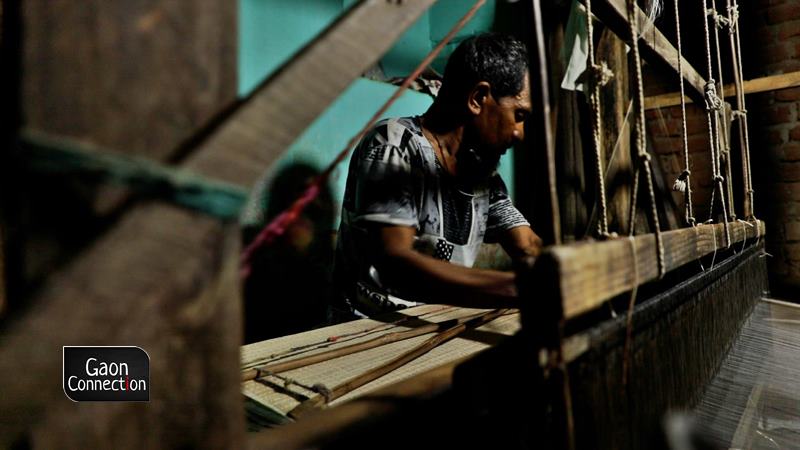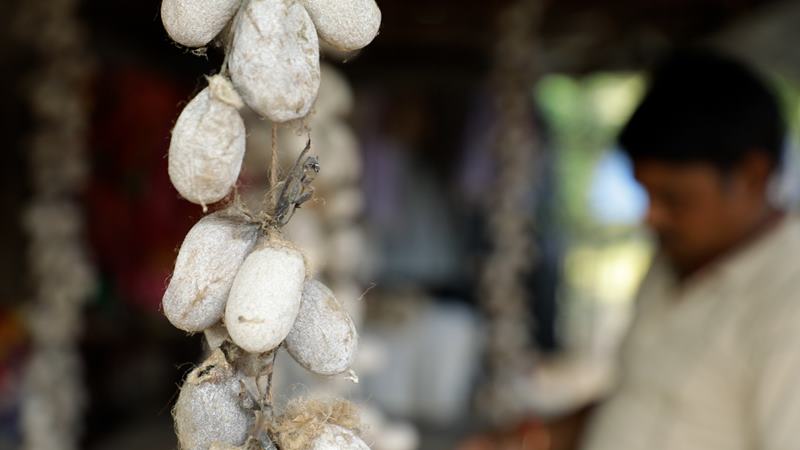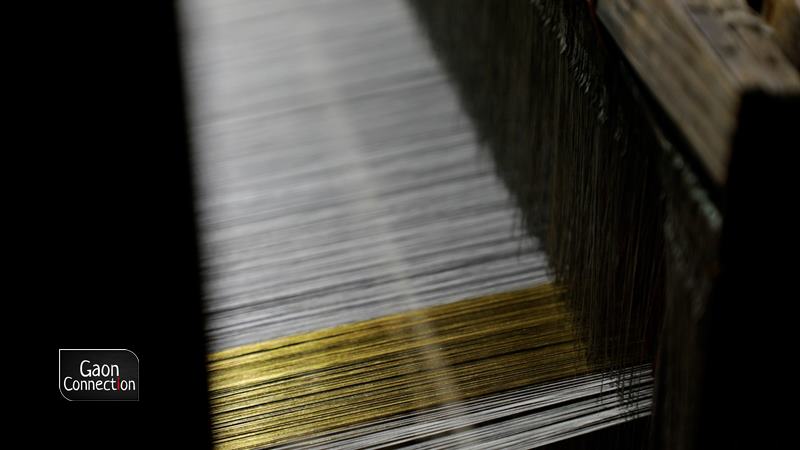The whisper of the world-famous Banka silk from Bihar is being silenced
The musical clatter of the handlooms that signalled the making of the beautiful tussar silk may be heard no more as the future of the traditional weavers of Banka hangs by a tenuous thread. Powerlooms, and now the pandemic, have sounded the death knell for these bunkars.

Banka, Bihar
A few rays of the sun struggle to enter the room through a narrow aperture high up near the ceiling. They weakly light up the unplastered walls and the two looms made of wood smoothened over years of wear and tear, that stand in a shallow pit on the rough mud flooring. Two men in their mid-40s face each other, weaving, their hands and feet moving continuously in rhythm.
Khat-khat-khat-khat, the gloomy room reverberates with the sound of the handloom as a tussar silk saree – off white with golden border – starts to take shape. The two bunkar (weavers) work on their respective looms silently, pausing only to fix the threads – at least a thousand of them – meticulously and intricately strung on the handloom.
“We sit in this position, weaving on the loom, for twelve hours a day and earn hundred rupees only,” 45-year-old bunkar Salamul Ansari, told Gaon Connection. Ansari began to weave when he was 20 years old, having learnt the craft from his vaalid sahab (father). “I have a handloom back at home too but it’s been fifteen years, since I have packed my loom as there is no work. I now work as a daily wager,”Ansari from Shobhanpur Katoriya village in Amarpur block of Banka, added.

Also Read: From peasants to princesses and every one in between, the Indian handloom sari has clothed them all
Banka district in Bihar, which was earlier a part of the Bhagalpur district, is known for its Banka tussar silk. This world-famous silk yarn is made from tussar cocoons and in its unfinished form, is coppery-gold and coarse in texture.
A large section of rural population in Banka and Bhagalpur districts in south Bihar is involved in raising silkworms for their cocoons. These silk cocoons are sold to the local traditional weavers – bunkars – who first make resham (silk) thread by spinning the charkha and then weave silk sarees on the handloom. These heavily priced tussar silk sarees, dupattas, kurtas, scarves, are sold across India and also shipped abroad.

While traders and middlemen thrive on these beautiful silk fabrics, those who weave them live in penury. And the COVID19 pandemic has left the bunkars struggling to feed their families.
“The tussar silk from Banka goes all over India and even abroad. But the pandemic and the lockdown has affected our work badly. We are sitting idle, waiting for the situation to improve, and waiting to receive our pending payment worth six to seven lakh rupees,” Bhim Narayan Singh, a farmer who raises silkworms for cocoons in Inaravaran village of Banka, told Gaon Connection.
Also Read: Beekeeping gives the Santhal tribal women in Banka, Bihar, a sweet taste of success

The district administration is working with the farmers who raise silkworms to help them get a better price for their cocoons. It is also planning programmes to promote products prepared by the weavers.
“Last year, Banka district produced about five crore [50 million] cocoons. We are working with the farmers to ensure the production increases in the coming years, and incomes of both the farmers and weavers rise too,” Suharsh Bhagat, district magistrate of Banka, told Gaon Connection.
Quietly, a weavers’ village is falling silent
About 250-kilometre southeast of Patna, the state capital of Bihar, lies Shobhanpur Katoriya. The village is famous for its traditional bunkars, who, for the past several generations, have been extracting silk from the cocoons of silkworms and weaving it on their looms to churn out light-weight tussar silk items including sarees that travel to distant locations.
“Humko hosh bhi nahi tha tab se yeh kaam kar rahe hain [I can’t even remember how young I was when I started this work]. I know my forefathers began weaving handloom tussars not less than 200 years ago,” Mohammad Ijaz, a weaver from Shobhanpur Katoriya, told Gaon Connection.

“But we are the last generation of bunkars because no one in the younger generation wants to carry forward our traditional occupation. Weaving on handloom requires hard work and the monetary returns are very low,” he added.
Also Read: Weavers of Shantipur in West Bengal wrapped up in gloom
Ijaz, in his 30s, has 60 other weavers working with him and all of them are above 40 years of age. “Mazdoori hi nahi mil pati. Bahut dayneey sthiti hai. Kuch din main vilupt ho jayega yeh kaam [Weavers do not even get their rightful daily wage. Their condition is pitiable. In the coming few years, handlooms will be extinct],” he rued.
Sixty-nine-year-old Haider Ali started weaving on a handloom when he was 15 years old. But he has dismantled his loom and said he had not woven anything for a decade now. There are several other weavers in his village who say they are the last generation of bunkars.
“Earlier each house in our village had a handloom. It was impossible to walk through the lanes without hearing the non-stop sound of the looms,” narrated Mohammad Ijaz. “Of the 450-500 handlooms in our village, now barely 150-200 looms are left, and soon they may fall silent too,” he added.
Talking about his childhood, Ijaz said that he remembers the time when his village supplied tussar silk yarn to Japan and America (United States of America): “My vaalid used to make us work day and night to complete the export consignment. I remember working on the loom in the light of a ghaslet (kerosene lamp). During the peak season, the village streets would reverberate with the sound of looms.”

Also Read: Varanasi: COVID-19 lockdown shatters the livelihoods of handloom weavers and traders
Now, these sought-after weavers sit idle through a large part of the year as power looms have hit their traditional occupation.
“There was a time we used to get a lot of orders and the earnings were good. But not any more. We sat idle at home for an entire year during the pandemic with no work at all,” said Mohammad Kamru, a weaver in his 60s, who too has been weaving since the age of 15.
Powerloom vs handloom
The advent and popularity of powerloom has sounded the death knell for the handloom weavers.
“How do we compete with the powerloom which makes five to six sarees in a day while we can weave only one saree in one-and-a-half or two days,” asked bunkar Ansari.
According to Ijaz, weaving one tussar silk saree involves the entire family: “The cocoons are first boiled and then resham is taken out by spinning on the wheel. This work is mostly done by women.”
“Thereafter, menfolk prepare the taana [warp] and the baana [weft] which is a highly skilled job of threading the yarns on the loom, after which the weaving begins,” he explained.
Also Read: These artisans from Benares weave colourful sarees but there’s no spark in their lives
For this entire process of getting one tussar silk saree ready, which takes two to three days, the weaver’s family earns Rs 500 per saree. “Can any family survive on an earning of Rs 500 in two to three days? It is hard to feed the children, hence the younger generation does not want to work on the handloom,” said Ijaz.
“Younger people from our village have migrated to cities like Bombay [Mumbai] where they work as tailors and earn Rs 25,000 to Rs 30,000 a month. Tailoring can be learnt in six months, but weaving on handloom is a different craft altogether,” Ijaz pointed out.

Naturally, 69-year-old Haider Ali is a worried man. “If the handlooms do not function at home, how will the younger generation learn the craft? Most of our kids have gone to pardes and prefer working as tailors there than sitting on the loom,” he lamented.
Ansari said that none of his children wanted to work on the handloom. “My kids don’t know how to string threads on the loom. The skill of preparing the taana and baana in my family will die with me,” he rued.
Also Read: A village that thrived on handloom, Cooch Behar’s Baburhat now has only one handloom mill
Bailing out the bunkars
Karmiha Devi of Inaravaran village in Banka rears tussar silk cocoons for a living. “Twice a year, I harvest cocoons and sell them. In a good year, I earn thirty thousand rupees,” Karmiha, a mother of two sons, told Gaon Connection. Both her sons help her with taking care of the silkworms and harvesting the cocoons.
“For two thousand cocoons, I earn between four to six thousand rupees,” the farmer added. Apart from rearing silkworms, she also grows paddy, maize and vegetables on a small patch of land.
Santosh Kumar Singh of Inaravaran village has been rearing silkworms since 2000 and was trained by the district administration. “Initially we started raising silkworms on Arjuna trees in the forest. In 2004, I planted 56,000 Arjuna trees and today I have 50,000 trees,” Santosh Kumar told Gaon Connection.

“Since I cannot take care of all the trees, I have given half my trees to another farmer to raise silkworms and harvest cocoons. In return, I get half of his earnings,” he explained.
Also Read: These weavers of Jammu want to revive the culture of age-old textile art
Santosh Kumar himself harvests a lakh (100,000) cocoons a year which fetches him between Rs 2.5 lakh and Rs 3 lakh. He earns another Rs 60,000-70,000 in a year by raising silkworm seeds in his grainage. “Twice a year, I harvest the cocoons. The October harvest of cocoons is sold to the traders to make silk items. The June-July harvest I use to make silkworm eggs to sell to other farmers,” he informed Gaon Connection.
The district administration is not unaware of the difficult position of Banka’s weavers and the farmers, mostly tribal people, who rear silkworms.
It is trying to raise the income of the farmers, such as Karmiha Devi and Santosh Kumar, who raise silkworms.
“Banka’s one lakh [100,000] hectares area is forest land. We have a large number of Arjuna and Sal trees that are suitable for cocoon growing and sericulture,” said Suharsh Bhagat, the district magistrate.
“Under the state government’s Jal-Jeevan-Haryali Mission, we have planned to increase the forest cover of Arjuna and Sal trees, which will boost the production of the cocoons. This will raise the income of farmers and also help in conserving the forests,” the official added.
Bhagat went on to say that the district administration was also looking at ways of making value additions to the silk products made by its weavers and artisans.
Can the bunkars of Banka hold on to their craft and survive the changing times, or will the threads snap?

